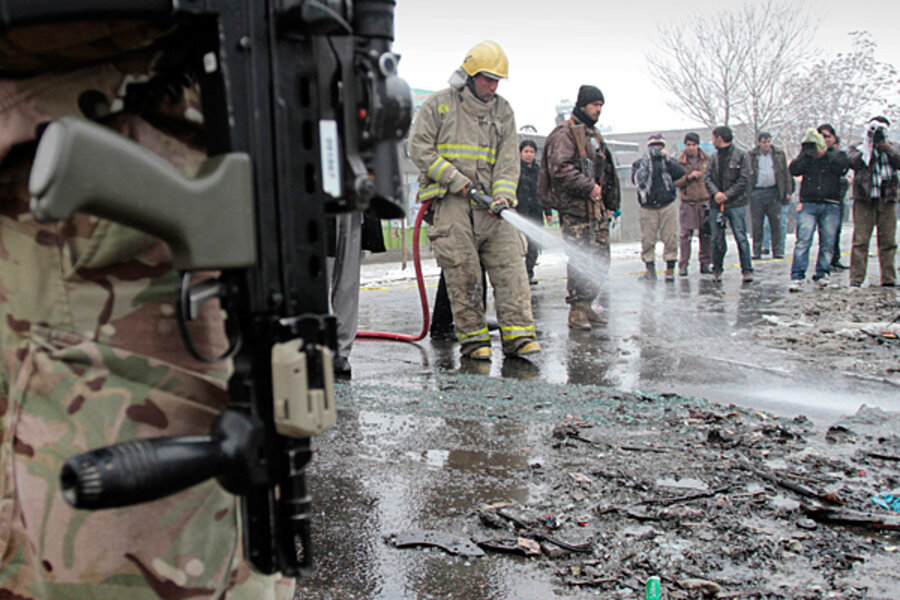Attack highlights how a corner of Afghanistan is falling apart
Loading...
Glance at a map of Afghanistan and the first thing you notice is the long finger of land jutting out of the country’s northeast – the Wakkan Corridor. The government’s ability to reach that area just became more questionable after an attack this weekend that killed 16 Afghan soldiers on the one road that connects it to Afghanistan proper.
I traveled that road in 2010. The area of the ambush – claimed by the Taliban – scared my driver then, who warned me that the next 15 minutes through the ominously-named Warduj district were going to be risky. Outside the windows of our jeep, we left a lightly-forested riparian village and struck east toward an open landscape ringed by the snowy mountains of the Pamir range, whose peaks form the roof of the world and whose slopes tumble into Pakistan, China, and Tajikistan.
Eyes in the jeep weren’t looking up but darting from rock to rock as the road twisted and turned through a giant uninhabited boulder field. The driver pointed out a scorch on the pavement from a recent attack on a police vehicle. The gunmen had hid behind the boulders to waylay the police, miles from any help.
Efforts at putting checkpoints around this area have gone badly, with the Taliban abducting 16 Afghan policemen and killing four others from one checkpoint in an incident last year a few months after German troops handed over security responsibility for the province.
This is Badakshan Province, one of the safest in Afghanistan – safety being a relative metric. Even here, local thugs are carving off chunks of territory for drug profits and power, aided by missteps from the international community and Afghanistan’s pre-existing divisions. To the extent the central government exercises control, it's to decide who gets to profit illegally from government posts.
Once out of the boulder field, prayers passed the lips of my driver and our eyes looked ahead towards Ishkashim, a city on the Afghan border with Tajikistan and gateway to the fabled Wakkan Corridor that juts out from Afghanistan’s borders like a stiletto. Ishkashim is one of two main border crossings that landlocked Afghanistan has with Tajikistan – the other passing through the more violent province of Kunduz. As such, it’s a lifeline of trade and supplies, and a big conduit for illicit drugs.
The United Nations estimates that Afghan smugglers sent 80 tons of heroin and 20 tons of opium into Tajikistan in 2010. In recent years, turf wars have erupted over control of the road to Ishkashim.
Security analyst Thomas Ruttig detailed some of those fights in an alarming writeup last August. At the time, a short-lived armed rebellion had broke out across the border in Tajikistan, led by the commander of the Tajik border police post at Ishkashim – a lucrative post if one is involved in smuggling. Mr. Ruttig argues the rebellion had its roots in the Afghan drug economy, as it appeared to touch off political infighting on the Afghanistan side which implied “rearrangements in drug-trafficking networks.”
One of those rearrangements came when Afghan officials arrested a district police chief named Qari Wadud that summer. According to Ruttig, Mr. Wadud had drug processing factories and was moving a lot of product out to Tajikstan. Tajik officials convinced their Afghan counterparts that Wadud was also playing a role in the unrest on the Tajik side of the border.
Uprooting such officials can touch off conflict for the Afghan government. During my visit to the province in 2010, I was woken one night in the city of Baharak by the steadily approaching sound of gunfire. Militants attacked the district government headquarters, destroying a portion of the building with a rocket. The source of the fighting might have been a disgruntled former official, according to a 2011 report from the Afghanistan Research and Evaluation Unit (AREU):
Recent security incidents in Baharak District were attributed to the replacement of the long-serving district police chief. In Baharak, the position is a lucrative one given its central position to trade in opium in the province, and the displaced chief is assumed by many to be behind the sudden rise in insecurity.
Baharak is the last major settlement on the road heading east to Ishkasham. Between lies the boulder field of Warduj, a district that has a significant number of insurgents. The pocket of fighters there is a puzzling development considering that the entire province contains almost no ethnic Pashtuns, who make up the vast majority of the insurgency elsewhere, and Badakshan was a last redoubt for the Northern Alliance during their darkest hours fighting the former Taliban government in Kabul. The insurgents in Warduj appear to be supporting themselves by infiltration routes from nearby Pakistan and possibly the drug trade that they allow to flow along the same road that they deny to police and army personnel.
From Ruttig’s report:
…the insurgents – who, since November [2011], regularly seem to have been positioning checkpoints on a key road leading from the provincial capital Faizabad to Baharak, Warduj and further on to Zebak, Ishkashem and Tajikistan – are also cooperating in the safe passage for drug convoys coming from Darayem and Baharak, as a ‘contribution to jehad’, namely by ‘sending drugs to the enemies of Islam’.
The gradual slide of Badakshan into a scrum for a piece of the poppy trade goes hand-in-hand with the return of poppy cultivation to the province. In the late 2000s, the province was considered nearly “poppy-free” as the United States Agency for International Development (USAID) promised to bring development to the province.
USAID would ultimately spend $60 million over four years, but spend it badly. Hydroelectric projects were left incomplete, newly-paved roads fell apart in months, and a pricey veterinary lab shut down when the government couldn’t keep paying salaries, according to an investigation I did for the Monitor.
Residents of Badakshan cite the failed promises as a reason for restarting the cultivation of poppy, according to the AREU report:
The informants in [Badakshan] were blunt about how far such efforts had fallen below their expectations.… [M]ost of the money that had been promised did not arrive, and the projects that did take place were not seen as bringing long-term benefits: “we have given up our weapons, given up poppy but there is nothing for income, the government has done nothing.”
The report found other reason that residents returned to poppy: Their sons who joined the Afghan military and served in southern provinces like Helmand noticed that the Afghan government and the US Marines there openly allowed farmers to cultivate poppy. At the same time, the southern Pashtun-dominated provinces were getting more development aid.
Both gripes are absolutely true. On an embed to the US mission’s southernmost outpost in 2010, the Marines in Helmand explained to me that the counterinsurgency thinking in vogue at the time meant that their mission was to win over the support of local residents. Nothing angered farmers working that ditch-scarred desert more than eradicating their poppy crops, so the Marines said they wouldn’t do that.
Instead, the US showered development money on the insurgency-ridden southern regions in the hope of shoring up support for the US-backed government. In Helmand, too, the projects are incomplete: The US just announced it won’t finish work on restoring the Kajaki dam, a projected needed to power the south; instead, money will be given to the Afghans to finish it.
Can the Afghan government keep control over such corners of a difficult and drug-fueled country to take up the work of nation-building? The news out of Badakshan isn't encouraging.








